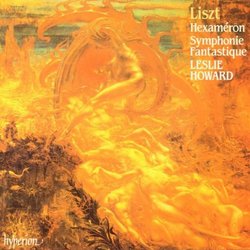| All Artists: Franz Liszt, Sigismund Thalberg, Johann Peter Pixis, Henri Herz, Carl Czerny, Frederic Chopin, Leslie Howard Title: Liszt: Hexaméron; Symphonie Fantastique Members Wishing: 1 Total Copies: 0 Label: Hyperion UK Release Date: 11/17/1993 Album Type: Import Genre: Classical Styles: Opera & Classical Vocal, Chamber Music, Forms & Genres, Short Forms, Historical Periods, Classical (c.1770-1830), Symphonies Number of Discs: 1 SwapaCD Credits: 1 UPC: 034571164335 |
Search - Franz Liszt, Sigismund Thalberg, Johann Peter Pixis :: Liszt: Hexaméron; Symphonie Fantastique
 | Franz Liszt, Sigismund Thalberg, Johann Peter Pixis Liszt: Hexaméron; Symphonie Fantastique Genre: Classical |
Larger Image |
CD Details |
CD Reviews"Transcription Fantastique"! P. Michael Mc Dermott | Greenwich CT | 12/31/1999 (5 out of 5 stars) "One of the defining masterworks of the symphony orchestra has to be Hector Berlioz' "Synphonie Fantastique" -- its sheer size, larger-than-life range of colorations and effects, and overwhelming emotions make it a work that could only have been written for a modern orchestra. Or maybe .... ? Enter Franz Liszt, the creator of the piano recital, the man described only half-facetiously by Tchaikovsky as the "Wizard of Weimar" ... and perhaps the only person who could transcribe and do justice to Berlioz' monumental work. Using his ten fingers, his uninhibited virtuosity and his uncanny ability to replicate the sound of an entire orchestra on a piano keyboard, Liszt more than does justice to his friend Berlioz in his amazing transcription of the "Symphonie Fantastique." For his part, Leslie Howard, in perhaps the most spectacular recording of his monumental 94-CD series of Liszt's complete piano compositions, gives an electrifying rendition of this work. Listeners, relax and enjoy ... and pianists, eat your hearts out!" Match made in heaven: Berlioz and Liszt P. Michael Mc Dermott | 09/17/1999 (5 out of 5 stars) "Liszt's transcription of his buddy Berlioz's Symphonie Fantastique is the reason to buy this CD. The rest ain't too shabby, either. Howard's performance is up to his usual high standards." Orchestral Spectacle turned into Partial Pianistic Tour de F C. Pontus T. | SE/Asia | 12/21/2009 (4 out of 5 stars) "To this reviewer, Berlioz's Fantastic Symphony has always been the greatest pre-Mahler symphonic spectacle. Therefore, a reduction for piano solo would seem a rather purposeless venture. Fortunately, Liszt immediately recognised the work's epoch-making greatness and prepared a complete transcription as early as 1833--less than three years after its premiere. Even if, naturally, the transcription cannot quite match the ingenious variety and range of the original, Liszt at least partially succeeded at transforming Berlioz's symphonic spectacle into a pianistic tour de force.
The first recording was made by Idil Biret in 1979. Although I have not heard it, I know her 1992 Naxos remake--as well as dozens of her Chopin, Brahms and Rachmaninov recordings. Hence, I can safely ascertain that Leslie Howard's 1990 version, as volume 10 of his complete Liszt survey, is the version to own, if not by a wide margin. Howard can at times be a magician technically, and so he is in the Witch's Sabbath where Liszt serves up a whole shebang of complex runs, leaps, tremolandi and glissandi--indeed, a bonbon for the aficionado of over-the-top piano extravaganza. In addition, Howard makes Scene in the Fields surprisingly evocative in its two-hand format. So, why then not a five-star rating? Liszt's transcription can easily sound unwieldy, especially in the Reveries-Passions, which Howard also does to some extent. Moreover, A Ball could be a great deal more lilting. Both March to the Scaffold and Dreams of a Witch's Sabbath are impressive in Howard's hands. However, he does not quite manage to create the same effect Liszt, reportedly, himself achieved when repeating the March on the piano during a performance of the Symphony--that is, surpassing the thrill of the full orchestra. Against that background, it is not hard to imagine what fireworks could be rendered if the likes of Kissin or Volodos were to take up at least these two movements. As for the main coupling, it is something so rare as a collaboration not only between the two greatest piano composers but also four of the then most celebrated keyboard lions--Thalberg, Pixis, Herz and Czerny. Indeed, Hexaméron is another pyrotechnic praline but quite frankly without that much lasting value--apart from the sixth variation, constituting one of Chopin's seemingly simple but alchemic Nocturnes. Again, Howard is a most humble and honest guide, although his fingers do not throw off the same amount of sparkle as do those of Raymond Lewenthal from 1964. All the same, with lifelike Kimpton Parish Church sound, this disc makes up one of the more desirable entries in Howard's tireless complete Liszt survey. TIMINGS: Symphony--14:18, 6:42, 13:26, 6:45, 10:13; Hexaméron--21:11 REFERENCES: Symphony--This One; Hexaméron--Lewenthal" |
